Solar eclipse of September 13, 2015
| Solar eclipse of September 13, 2015 | |
|---|---|
 From the Solar Dynamics Observatory | |
| Type of eclipse | |
| Nature | Partial |
| Gamma | −1.1004 |
| Magnitude | 0.7875 |
| Maximum eclipse | |
| Coordinates | 72°06′S 2°18′W / 72.1°S 2.3°W |
| Times (UTC) | |
| Greatest eclipse | 6:55:19 |
| References | |
| Saros | 125 (54 of 73) |
| Catalog # (SE5000) | 9542 |
A partial solar eclipse occurred on September 13, 2015.[1][2][3] A solar eclipse occurs when the Moon passes between Earth and the Sun, thereby totally or partly obscuring the image of the Sun for a viewer on Earth. A partial solar eclipse occurs in the polar regions of the Earth when the center of the Moon's shadow misses the Earth.
Images
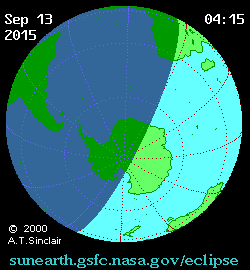 Animated path |
 View from center of sun |
Related eclipses
Eclipses of 2015
- A total solar eclipse on March 20.
- A total lunar eclipse on April 4.
- A partial solar eclipse on September 13.
- A total lunar eclipse on September 28.
Solar eclipses ascending node 2015-2018
- Saros 125: Partial Solar Eclipse September 13, 2015
- Saros 135: Annular Solar Eclipse September 1, 2016
- Saros 145: Total Solar Eclipse August 21, 2017
- Saros 155: Partial Solar Eclipse August 11, 2018
Solar eclipses 2015–2018
This eclipse is a member of a semester series. An eclipse in a semester series of solar eclipses repeats approximately every 177 days and 4 hours (a semester) at alternating nodes of the Moon's orbit.[4]
The partial solar eclipse on July 13, 2018 occurs in the next lunar year eclipse set.
| Solar eclipse series sets from 2015 to 2018 | ||||||
|---|---|---|---|---|---|---|
| Descending node | Ascending node | |||||
| Saros | Map | Gamma | Saros | Map | Gamma | |
120 Totality in Longyearbyen, Svalbard |
March 20, 2015 Total |
0.94536 | 125 Solar Dynamics Observatory |
September 13, 2015  Partial |
−1.10039 | |
130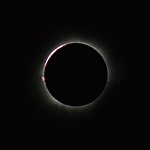 Balikpapan, Indonesia |
March 9, 2016 Total |
0.26092 | 135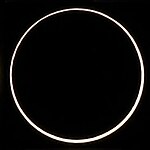 Annularity in L'Étang-Salé, Réunion |
September 1, 2016 Annular |
−0.33301 | |
140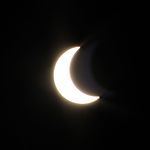 Partial from Buenos Aires, Argentina |
February 26, 2017 Annular |
−0.45780 | 145 Totality in Madras, OR, USA |
August 21, 2017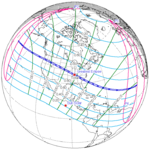 Total |
0.43671 | |
150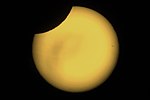 Partial in Olivos, Buenos Aires, Argentina |
February 15, 2018 Partial |
−1.21163 | 155 Partial in Huittinen, Finland |
August 11, 2018 Partial |
1.14758 | |
Metonic series
The metonic series repeats eclipses every 19 years (6939.69 days), lasting about 5 cycles. Eclipses occur in nearly the same calendar date. In addition, the octon subseries repeats 1/5 of that or every 3.8 years (1387.94 days). All eclipses in this table occur at the Moon's ascending node.
| 21 eclipse events between July 1, 2000 and July 1, 2076 | ||||
|---|---|---|---|---|
| July 1–2 | April 19–20 | February 5–7 | November 24–25 | September 12–13 |
| 117 | 119 | 121 | 123 | 125 |
 July 1, 2000 |
 April 19, 2004 |
 February 7, 2008 |
 November 25, 2011 |
 September 13, 2015 |
| 127 | 129 | 131 | 133 | 135 |
 July 2, 2019 |
 April 20, 2023 |
 February 6, 2027 |
 November 25, 2030 |
 September 12, 2034 |
| 137 | 139 | 141 | 143 | 145 |
 July 2, 2038 |
 April 20, 2042 |
 February 5, 2046 |
 November 25, 2049 |
 September 12, 2053 |
| 147 | 149 | 151 | 153 | 155 |
 July 1, 2057 |
 April 20, 2061 |
 February 5, 2065 |
 November 24, 2068 |
 September 12, 2072 |
| 157 | ||||
 July 1, 2076 | ||||
References
- ^ Orwig, Jessica. "A NASA video shows what a total lunar eclipse looks like from the moon, and it's mind-blowing". Business Insider.
- ^ European Space Agency. "Image: Proba-2 captures partial solar eclipse". phys.org.
- ^ Wall, Mike (September 12, 2015). "Watch Sunday's Partial Solar Eclipse Live in Slooh Webcast". Space.com.
- ^ van Gent, R.H. "Solar- and Lunar-Eclipse Predictions from Antiquity to the Present". A Catalogue of Eclipse Cycles. Utrecht University. Retrieved 6 October 2018.




